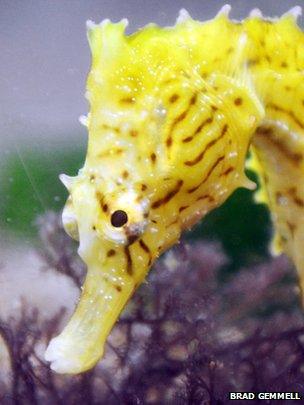Seahorses stalk their prey by stealth
- Published
When seahorses attack
Seahorses may appear slow and awkward but they are ferocious and ingenious predators, according to a new study.
The beautiful creatures are famously bad swimmers, but they have a secret weapon to sneak up on their prey.
Their peculiar snouts are shaped to create very few ripples in the water, effectively cloaking them as they creep up and pounce on tiny crustaceans.
To their victims, seahorses are more like sea monsters, say scientists from the University of Texas at Austin.
"The seahorse is one the slowest swimming fish we know of, but it's able to capture prey that swim at incredible speeds," said Brad Gemmell, author of the study in Nature Communications, external.
The prey, in this case, are copepods - extremely small crustaceans that are a favoured meal of seahorses, pipefish and sea dragons (Syngnathidae).
When copepods detect waves from predators, they jolt away at speeds of more than 500 body lengths per second - the equivalent of a 6-foot human swimming at 2,000 mph.
Deadly strike
"Seahorses can overcome one of the most talented escape artists in the aquatic world," said Dr Gemmell.
"In calm conditions, they catch their intended prey 90% of the time. That's extremely high, and we wanted to know why."

The dwarf seahorse may look delicate, but its snout is a lethal weapon
Seahorses dine by a method known as pivot feeding. Their arched necks act as a spring - allowing them to rapidly rotate their heads and suck their prey in.
But this suction only works at short distances. The effective strike range for seahorses is about 1mm. And a strike happens in less than 1 millisecond.
Until now, it was a mystery how such apparently docile creatures managed to get close enough to their prey without being spotted.
To find out, Dr Gemmell and his colleagues studied the dwarf seahorse, Hippocampus zosterae, which is native to the Bahamas and the US.
They filmed the movement of water around the fish in 3D using holography - a technique where a microscope is fitted with a laser and a high-speed digital camera.
They found that the seahorse's snout is shaped to minimise the disturbance of water in front of its mouth before it strikes.
Above and in front of its nostrils is a "no wake zone" and it angles its head precisely to attack its prey.
Other small fish with blunter heads, such as the three-spine stickleback, have no such advantage, the researchers found.
"It's like an arms race between predator and prey, and the seahorse has developed a good method for getting close enough so that their striking distance is very short," said Dr Gemmell.
"People don't often think of seahorses as amazing predators, but they really are."
Related topics
- Published26 November 2013
- Published21 January 2011
- Published7 October 2011
- Published24 August 2012
- Published6 July 2012